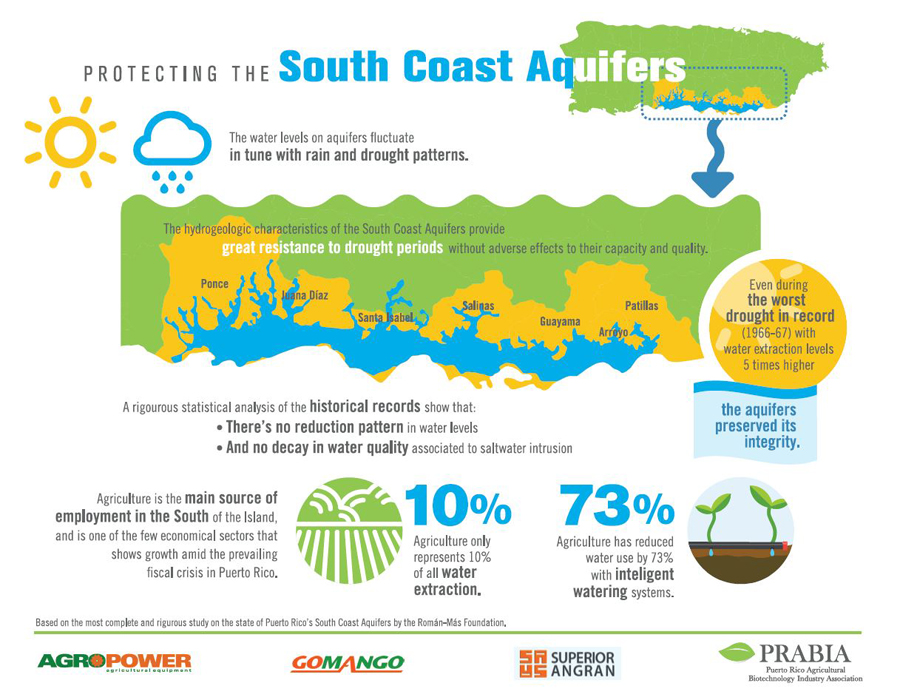Study claims P.R.’s southern aquifers are ‘healthy, efficient and resilient’

Despite the moderate drought that recently affected parts of the island, a new study belies the notion that there is a crisis in the aquifers of Puerto Rico’s southern region, a natural source of water that is critical for the area’s agricultural sector.
According to the data exposed in the study, these bodies of water are in good condition and do not face any threat from agriculture.
The study of the Aquifers of the South was commissioned to the Román-Más Foundation and carried out by Ángel Román-Más, hydrologist and Foundation chairman, as a collaboration between the Puerto Rico Agriculture Department, the Agricultural Development Innovation Fund, the Puerto Rico Land Authority, AgroPower, Gomango, Superior Angran and the Puerto Rico Agricultural Biotechnology Industry Association.
It is the first time that such a comprehensive and conclusive study of the behavior of 179 wells in the south and southwest of the island has been done, the group said.
“The extraction of groundwater has been reduced significantly, around 73%. In the Alluvial Fan in Salinas, groundwater withdrawals by the agricultural sector account for about 10% of the total extraction and less than 4% of the extractions in the late 1980s,” said Román-Más.
“This reduction in the use of water for the agricultural sector responds to the implementation of more efficient irrigation systems — precision and smart — established in all agricultural biotechnology companies,” he said
Ramón González, farmer and president of AgroPower, said, “for more than 100 years his family has been dedicated to agriculture and finally have a scientific study that confirms and verifies, with data from four consecutive years, what every farmer knows; that the aquifer has a cyclical behavior. We know that from January to May it does not rain due to the dry weather and then the aquifer recharges during the rainy season.”
- Other key findings of the study show that: Historical records do not reflect a pattern of long-term reduction in water levels or a deterioration in water quality associated with the intrusion of brackish sea water;
- The aquifers of the South have an “extraordinary resilience” to periods of drought that is given by the occurrence of artesian conditions along the coast that prevent the development of a hydraulic gradient and therefore the advance of the cradle of brackish water coming from the sea; and,
- The aquifers of the South have additional capacity to maintain the region’s agricultural development to reach the goals of the Food Security Program without diminishing the availability of water for the domestic sector.
“The main finding of this independent study is that agriculture, at all levels, is being practiced in a sustainable manner and respectful to the natural environment, with a special focus on efficiency,” said Sol Rosado, president of PRABIA.
“And although it establishes that agriculture is not the biggest offender in the face of lack of water, everyone — both small and large-scale farmers, as well as citizens — has an obligation to manage this resource responsibly,” she said.
Rosado stressed that the companies that are part of PRABIA operate under a deep social and environmental commitment framed in agriculture that is sustainable, responsible and for the benefit of the island.
“A rigorous statistical analysis of historical records of water levels and quality, including a Mann-Kendall test with individual data and annual averages, does not reflect a long-term reduction pattern at the water table or a deterioration in water quality,” Román-Más said.
“So any conclusion to the effects of an over exploitation of the aquifer depending on the historical pattern or behavior of the water table and water quality is incorrect or at least not statistically defensible,” he said.
“However, we know that the aquifers have a limit, unknown at present, that describes a drought of such magnitude that, under a particular scenario of extractions, it would cause the loss of artesian pressures along the coast leading the advance of the brackish water cradle from the sea that we must study and define,” he said.
“This is a matter that deserves more research in the future,” said Román-Más, who also recalled that even during the most severe drought in record (1966-67), when the groundwater extractions were more than five times those done at present, the aquifers maintained their integrity.







